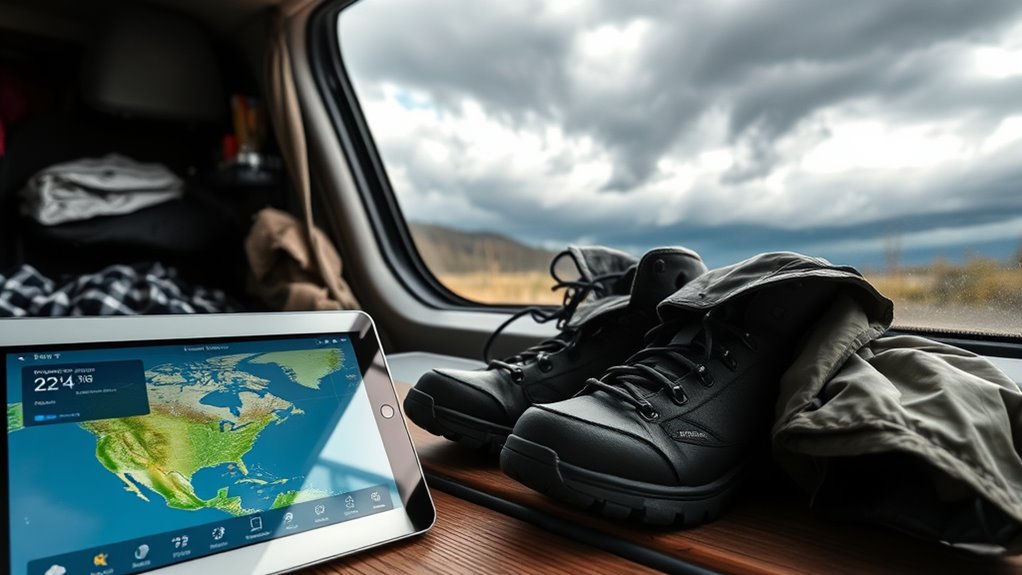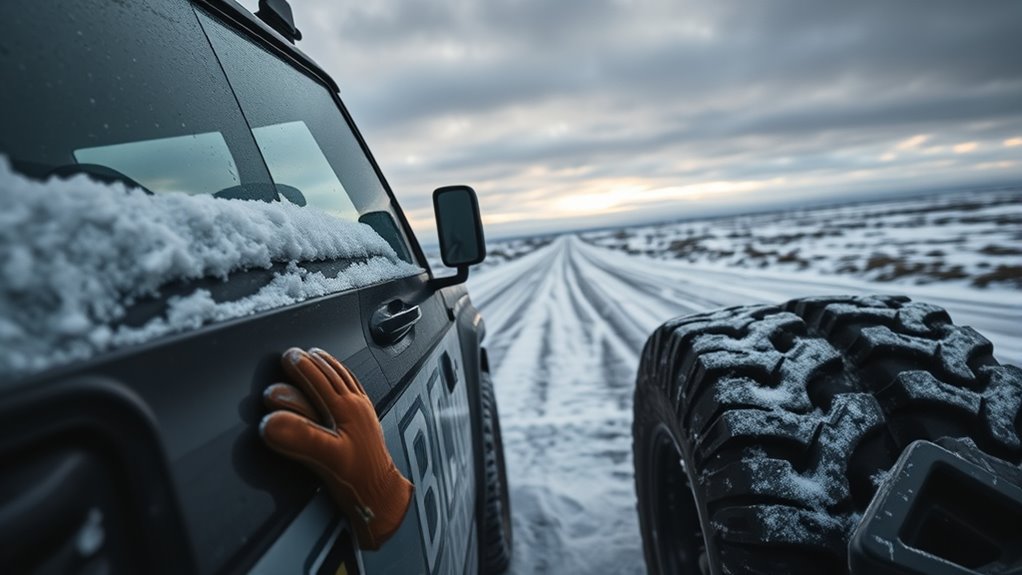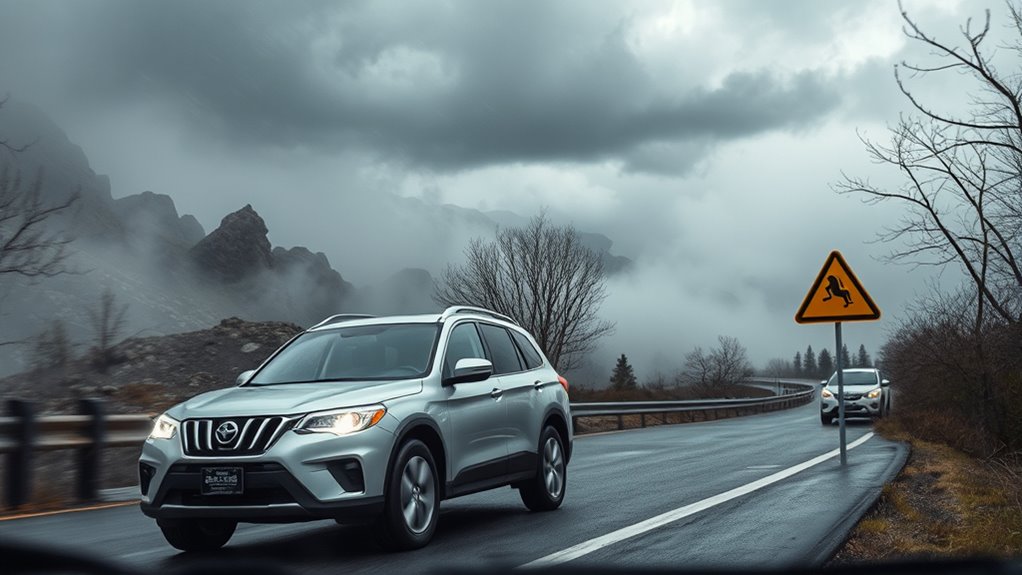To prepare for weather challenges on the road, regularly check updated forecasts and plan alternative routes ahead of time. Pack essential safety gear like a flashlight, jumper cables, and blankets. Make sure your vehicle is ready by inspecting tires, fluids, and emergency supplies. Adapt your driving style by reducing speed and increasing following distance, especially in fog, rain, or snow. Staying alert and calm helps you respond effectively to sudden weather changes. To discover how to stay safe, keep exploring these crucial tips.
Key Takeaways
- Regularly check weather forecasts and stay updated on evolving conditions to adjust travel plans proactively.
- Ensure vehicle safety by inspecting tires, fluids, battery, and packing emergency supplies and safety gear.
- Plan reliable detours and rerouting options before departure to bypass hazardous areas safely.
- Reduce speed, increase following distance, and use appropriate lighting to maintain control and visibility in poor weather.
- Keep emergency kits accessible and stay calm to respond effectively to unexpected weather changes and post-storm conditions.
Monitoring Weather Forecasts Before Your Trip

Before hitting the road, it’s vital to check the latest weather forecasts to stay ahead of any potential storms or hazardous conditions. Monitoring weather patterns helps you understand upcoming changes, so you can plan accordingly. Pay attention to forecast accuracy, as some predictions can be more reliable than others. Use trusted sources like national weather services or weather apps to get real-time updates. If forecasts indicate severe weather, consider adjusting your travel plans or delaying your trip. Regularly checking the forecast ensures you’re aware of evolving conditions, reducing surprises during your journey. By staying informed about weather patterns and forecast accuracy, you can make smarter decisions, keeping yourself and others safe when navigating challenging weather conditions. Understanding forecast reliability can help you better assess the risks and take appropriate precautions.
Packing Essential Safety Gear for Inclement Conditions

When preparing for inclement weather, packing the right safety gear is crucial to guarantee your safety on the road. You should bring emergency supplies like bottled water, non-perishable snacks, a flashlight, batteries, and a basic first aid kit. These essentials can make a big difference if you get stranded or face delays. Safety gear such as a reflective vest, sturdy gloves, and a blanket can help protect you and make you more visible in bad conditions. Keep a multi-tool or knife handy for minor repairs or emergencies. Remember, being prepared with the right emergency supplies and safety gear ensures you’re ready to handle unexpected weather challenges confidently and safely. Always double-check your gear before hitting the road. Additionally, understanding weather preparedness can significantly improve your safety during adverse conditions.
Ensuring Your Vehicle Is Ready for Challenging Weather

Before hitting the road in bad weather, make sure your tires have enough tread for safe traction. Check that your emergency kit is stocked with essentials like a flashlight, jumper cables, and first aid supplies. Being prepared starts with a vehicle ready to handle challenging conditions. Additionally, reviewing vehicle maintenance tips can help ensure your car is in optimal shape for adverse weather.
Tire Tread Inspection
Ensuring your tires have sufficient tread depth is essential for safe driving in challenging weather conditions. Your tire tread helps channel water, snow, and mud away from the contact patch, reducing the risk of hydroplaning or slipping. To check tread depth, use a simple method like the penny test—place a penny into the tread grooves with Lincoln’s head facing down. If you can see the top of Lincoln’s head, your tread is too shallow. Most experts recommend a minimum tread depth of 2/32 inch for safe driving. Regularly inspecting your tire tread ensures you can identify when it’s time for new tires, especially before severe weather hits. Proper tread depth enhances traction and control, keeping you safer on wet or icy roads. Additionally, understanding tire maintenance can help extend the lifespan of your tires and improve overall safety.
Emergency Kit Essentials
Having properly maintained tires with adequate tread depth is just one part of preparing for challenging weather on the road. An indispensable step is assembling an emergency kit to handle unexpected situations. Your kit should include crucial items like a first aid kit, flashlight, jumper cables, non-perishable snacks, and a blanket. Also, check your vehicle maintenance needs regularly, such as fluid levels and battery health, to prevent breakdowns. A well-stocked emergency kit ensures you’re ready for weather-related issues, like being stranded or needing minor repairs. Keep these essentials in your trunk or glove compartment, and review them periodically to replace expired items. Being prepared with the right tools and supplies can make all the difference during severe weather conditions. Understanding emergency preparedness and having the proper supplies can significantly improve your safety during unexpected weather events.
Adjusting Your Driving Style to Weather Conditions

When weather conditions worsen, adjusting your driving style becomes essential for safety. You should focus on maintaining vehicle stability by easing off the accelerator and steering smoothly. Sudden movements can cause loss of control, especially on wet or icy roads. Pay attention to driving ergonomics by sitting upright and keeping a firm grip on the wheel, which helps you respond quickly to changing conditions. Reduce your speed to give yourself more reaction time and better control. Increase following distances to avoid rear-end collisions. Use your headlights in fog or rain to improve visibility. Staying alert and adapting your driving habits ensures you stay stable and safe, minimizing the risk of accidents caused by weather-related hazards. Incorporating electric bikes into your routine can also be a sustainable way to navigate weather challenges, especially in urban environments.
Planning Alternative Routes to Avoid Severe Weather

To stay safe, you need to keep an eye on weather updates before and during your trip. Mapping out reliable detours guarantees you avoid the worst conditions, saving you time and stress. Make sure to communicate any route changes clearly to everyone involved to stay coordinated and prepared. Using a world clock tool can help you monitor local weather patterns across different time zones efficiently.
Monitoring Weather Updates
Staying informed about current weather conditions is essential for planning safe routes during severe weather. To do this effectively, rely on reliable weather apps that provide real-time updates and forecast alerts. These tools help you stay ahead of changing conditions and adjust your plans accordingly. Be sure to:
- Enable push notifications for immediate forecast alerts
- Check radar maps for approaching storms
- Review hourly weather updates
- Follow local weather stations on social media
- Set alerts for severe weather warnings in your area
- Recognize the importance of understanding wave and wind patterns that can impact coastal travel.
Mapping Safe Detours
Planning safe detours is essential when severe weather threatens your route. Effective detour planning involves identifying route alternatives before you hit the road, so you’re prepared if conditions worsen. Use navigation apps and weather updates to pinpoint roads affected by storms, flooding, or snow. Map out alternatives that bypass hazardous areas, considering factors like road closures or construction. Keep a printed map or saved routes handy in case digital tools fail. Prioritize routes with better weather conditions and less traffic to ensure safety and efficiency. Regularly reassess your detour plan as weather changes, and be ready to adapt quickly. Proper route alternatives can save you time and reduce risks, helping you navigate safely through challenging weather situations. Family Photoshoot Fails can sometimes lead to unexpected delays, so planning ahead is crucial.
Communicating Changes Efficiently
Once you’ve identified safe detours, communicating these route changes clearly and promptly becomes essential. Effective traffic communication and timely emergency alerts ensure everyone stays informed and avoids hazards. Use multiple channels—radio broadcasts, mobile apps, and GPS updates—to reach drivers quickly. Keep messages concise, highlighting key details like new routes, estimated travel time, and hazards to watch for. Confirm that your emergency alerts are loud and clear, especially in areas with high traffic. Share updates regularly to prevent confusion and congestion. Encourage drivers to stay alert and check for real-time updates. Employ real-time traffic monitoring to enhance communication accuracy and responsiveness. Clear communication minimizes delays and accidents, helping everyone navigate safely around severe weather. Remember, swift and precise traffic communication saves lives and keeps your journey smooth.
Recognizing and Responding to Hazardous Road Conditions

Recognizing hazardous road conditions early can make all the difference in maintaining control and avoiding accidents. Keep an eye on the road surface; look for slick spots, potholes, or debris that could cause loss of traction. Pay close attention to pavement markings, as they often indicate changes in road conditions or lane boundaries. Faded or obscured lines may signal wet or icy patches ahead, requiring you to slow down and proceed with caution. Notice any irregularities, such as standing water or ice patches, especially after adverse weather. Be aware of Halloween-themed decorations that may be temporarily placed near roadways, which can be distracting or obstructive. Respond promptly by reducing speed, increasing following distance, and avoiding sudden maneuvers. Staying alert to these signs helps you react safely and adapt quickly, preventing accidents caused by hidden hazards on the road.
Managing Visibility During Fog, Rain, and Snow

When weather conditions like fog, rain, or snow reduce visibility, it’s essential to adjust your driving habits to stay safe. Fog visibility can be tricky; use low-beam headlights and fog lights to improve your view without causing glare. During snow, watch out for snow glare, which can impair your vision and make it harder to see obstacles. Here are some tips:
- Reduce your speed and increase following distance
- Use headlights appropriately—avoid high beams in fog or snow glare
- Keep your windshield clean and wipers in good condition
- Avoid sudden movements and sharp turns
- Stay in your lane and avoid passing unless absolutely necessary
- Being aware of your surroundings and potential hazards can further enhance safety in adverse weather conditions security awareness.
These steps help you maintain better visibility and prevent accidents in challenging weather conditions.
Handling Unexpected Weather Changes on the Road

Unexpected weather changes can happen suddenly, so staying alert and prepared is crucial for safe driving. To handle these surprises, focus on seasonal preparation by adjusting your vehicle and driving habits for different weather conditions. Keep an emergency kit, including blankets, a flashlight, and extra supplies, in your car. Weather awareness is key; pay attention to weather forecasts and road signs that indicate changing conditions. Slow down when you notice fog, rain, or sleet, and increase your following distance to give yourself more reaction time. If you encounter unexpected snow or ice, avoid sudden movements and steer gently. Being adaptable and aware of current weather conditions helps you respond swiftly and stay safe when nature throws a curveball. Self Watering Plant Pots are a good example of gardening tools designed to reduce overwatering and maintenance, which can be useful for busy travelers or those managing outdoor plant care in changing weather.
Staying Calm and Focused in Stormy Conditions

When storms hit, staying calm and focused helps you navigate safely. Take deep, steady breaths to keep your mind clear and avoid panic. Concentrate on road safety, so you can react effectively to changing conditions.
Maintain Steady Breathing
Maintaining steady breathing is essential for staying calm and focused during stormy driving conditions. When the weather worsens, take slow, deep breaths to help manage stress and keep your mind clear. Focus on your breath to prevent panic and stay alert. To improve your technique, try:
- Inhaling deeply through your nose
- Exhaling slowly through your mouth
- Counting your breaths to maintain rhythm
- Centering your attention on each inhale and exhale
- Using deep breathing as a stress reduction tool
These simple actions help you stay present and avoid feeling overwhelmed. Remember, controlled breathing enables you to respond calmly to changing conditions, making your drive safer and more manageable despite the storm. Breathing techniques are a vital tool for maintaining composure in challenging weather.
Keep Calm Mindset
Staying calm and focused during stormy conditions can considerably improve your ability to handle challenging driving situations. Maintaining a keep calm mindset helps you manage stress effectively, preventing panic from clouding your judgment. When you stay centered, your mental resilience strengthens, allowing you to react thoughtfully rather than impulsively. Practice deep breathing, positive self-talk, and visualization techniques to reinforce your composure. Remember, staying calm isn’t just about feeling relaxed; it’s about controlling your responses and staying alert. By managing stress proactively, you reduce the risk of mistakes and improve your overall safety. Cultivating a calm mindset prepares you mentally for unpredictable weather, helping you navigate stormy roads with confidence and clarity. Additionally, understanding the risks associated with market volatility can help you stay grounded and make informed decisions under pressure.
Focus on Road Safety
In stormy conditions, focusing on road safety means keeping your attention firmly on your driving and the environment around you. Stay alert and maintain driver awareness to react quickly to changing conditions. Ensure your vehicle is properly maintained—check tires, brakes, and wipers to handle wet or icy roads. Keep a safe distance from other vehicles, reduce speed, and avoid sudden maneuvers. Use headlights and defrosters effectively to improve visibility. Be mindful of your mental state; stay calm and avoid distractions. Remember, your focus can prevent accidents and keep everyone safe. Additionally, understanding latest breakthroughs in machine learning tech can help you stay informed about emerging AI tools that can enhance vehicle safety features.
Post-Weather Driving Tips for Safe Travel Recovery

After a storm or heavy rain, it’s essential to take quick, deliberate steps to guarantee your safety and get your vehicle back in good shape. Start with a thorough vehicle maintenance check—inspect tires for damage or reduced tread, brakes, and fluid levels. Clear any debris from your vehicle’s exterior and undercarriage. Once your vehicle is safe to drive, reassess your road trip planning; consider rerouting if roads are damaged or flooded. Drive cautiously, reducing speed to handle slick surfaces and potential hazards. Keep an emergency kit handy in case of breakdowns. Remember, taking these post-weather recovery steps ensures your safety and helps you get back on the road more quickly. Proper venting and chimney maintenance are key after weather disruptions to prevent hazards and ensure safe operation.
Frequently Asked Questions
How Can I Stay Informed About Sudden Weather Updates During My Trip?
You can stay informed about sudden weather updates during your trip by using weather apps on your phone. These apps provide real-time forecasts and quick alerts on changing conditions. Make sure to enable emergency alerts, which notify you immediately of severe weather warnings. Regularly checking your app and keeping your device charged guarantees you receive timely updates, helping you stay safe and make informed decisions while on the road.
What Are the Best Safety Measures for Driving in Icy Conditions?
When driving in icy conditions, you should prioritize safety by maintaining your tires properly, ensuring they have adequate tread and proper inflation. Drive slowly and increase your following distance to prevent slipping. Keep an emergency kit in your vehicle, including blankets, food, and a flashlight, in case you get stranded. Avoid sudden movements, and stay alert to changing road conditions to stay safe on icy roads.
How Do I Handle a Vehicle Skidding on Wet or Icy Roads?
When your vehicle skids on wet or icy roads, stay calm and avoid panicking. You should gently steer into the skid to regain vehicle control, avoiding sudden movements. To prevent skids, reduce your speed, increase following distance, and steer smoothly. Keep your tires properly inflated and make sure good tread. Remember, skid prevention is key to safety. Stay alert and adjust your driving to conditions, so you can handle any slippery surprises effectively.
What Should I Do if My Vehicle Gets Stuck in Snow or Flooding?
If your vehicle gets stuck in snow or flooding, stay calm and assess the situation. Use your vehicle recovery skills to gently free it, avoiding spinning the tires excessively. Keep emergency supplies like blankets, water, and a flashlight handy in case you need to wait for help. If flooding is severe, prioritize safety by leaving the vehicle if it’s unsafe to stay inside and call emergency services.
How Can I Prevent Fatigue During Long Drives in Bad Weather?
Imagine you’re on a long, stormy drive when fatigue starts to hit. To prevent this, you should plan regular rest breaks every two hours, allowing you to stretch and refresh. Stay hydrated with water or electrolyte drinks, which help maintain alertness. Avoid heavy meals that make you sleepy. By following these hydration strategies and taking breaks, you’ll stay focused and safe during challenging weather conditions.
Conclusion
Being prepared can make all the difference—did you know that nearly 76% of weather-related crashes happen during rain, snow, or sleet? By monitoring forecasts, packing safety gear, and adjusting your driving, you’re markedly reducing your risk. Stay vigilant, keep calm, and adapt to changing conditions. With the right preparation, you can navigate weather challenges confidently and arrive safely, no matter what Mother Nature throws your way.









